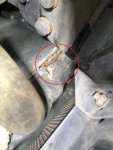T9000
Well-known member
- 489
- 370
- 63
- Location
- California
Exactly!
And talking about flux capacitors lol, I am still laughing at the picture...here is something more in that direction, but not so esoteric...
I didn't spend time on the the details yet, but as a big picture concept, there is at least one other option to increase power without modifying the engine so the connecting rods stay in their place and even if they decide to come out for a beer on the side of the block, I can still post on this board lol
Given the latest advances in power & energy densities and magnetics, we could now replace the 200A alternator with a roughly 50kW BLDC for about the same size/ weight or even smaller, plus a bidirectional controller plus a small battery pack (the exact lithium chemistry TBD based on the application climate and overall thermal management strategy).
This could add about 50-60HP and at least 100 ft-lb of torque at very low RPMs for about $3k-$4k depending on the battery pack size and it will also add some regenerative braking ability that would be used to re-charge the batteries and improve fuel efficiency.
Of course several sensors would have to be added to synchronize the two motors power delivery, fail safe systems (even if the regenerative braking stops working, the regular brakes would take over, etc), some micro-controllers running code at the hardware level and system level, which are all typical in most cars these days. Being a brushless motor even if everything stops working it would add very little load to the existing engine. On the other hand, if the battery pack is large enough, even if the rods decide to come out it could still buy you a little time to get out of the road (unless the crankshaft shatters, in which case it could be installed on the other side of it, but it adds another level of complexity).
This mild-hybrid strategy has been applied by GMC (eAssist) and RAM (eTorque) but at a smaller scale (3-5kW) to keep the cost down. They charge about $1,500 for the option, which it means the parts cost about $600.
Of course another factor is the serpentine belt, which limits the amount of power that can be paralleled to the crankshaft so a direct-drive / chain type coupling would be needed for higher power levels.
Just another thought along the flux capacitor line, but based more on some reality...talking about having fun lol
And talking about flux capacitors lol, I am still laughing at the picture...here is something more in that direction, but not so esoteric...
I didn't spend time on the the details yet, but as a big picture concept, there is at least one other option to increase power without modifying the engine so the connecting rods stay in their place and even if they decide to come out for a beer on the side of the block, I can still post on this board lol
Given the latest advances in power & energy densities and magnetics, we could now replace the 200A alternator with a roughly 50kW BLDC for about the same size/ weight or even smaller, plus a bidirectional controller plus a small battery pack (the exact lithium chemistry TBD based on the application climate and overall thermal management strategy).
This could add about 50-60HP and at least 100 ft-lb of torque at very low RPMs for about $3k-$4k depending on the battery pack size and it will also add some regenerative braking ability that would be used to re-charge the batteries and improve fuel efficiency.
Of course several sensors would have to be added to synchronize the two motors power delivery, fail safe systems (even if the regenerative braking stops working, the regular brakes would take over, etc), some micro-controllers running code at the hardware level and system level, which are all typical in most cars these days. Being a brushless motor even if everything stops working it would add very little load to the existing engine. On the other hand, if the battery pack is large enough, even if the rods decide to come out it could still buy you a little time to get out of the road (unless the crankshaft shatters, in which case it could be installed on the other side of it, but it adds another level of complexity).
This mild-hybrid strategy has been applied by GMC (eAssist) and RAM (eTorque) but at a smaller scale (3-5kW) to keep the cost down. They charge about $1,500 for the option, which it means the parts cost about $600.
Of course another factor is the serpentine belt, which limits the amount of power that can be paralleled to the crankshaft so a direct-drive / chain type coupling would be needed for higher power levels.
Just another thought along the flux capacitor line, but based more on some reality...talking about having fun lol









